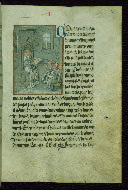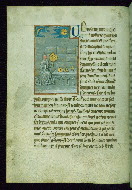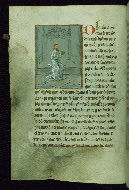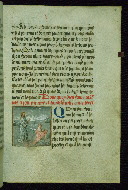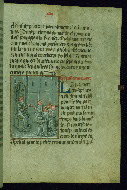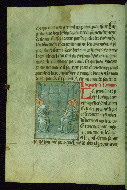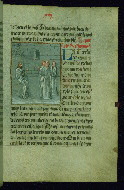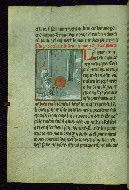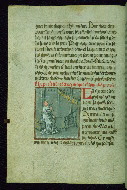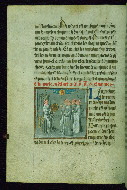Home > Digitized Walters Manuscripts
This document is a tranformation of a TEI P5 XML manuscript description incorporating images. If you have trouble reading special or non-Latin characters on this page, please make sure you have appropriate Unicode fonts installed and an up-to-date web browser.
Walters Ms. W.199, Gossouin of Metz, Image du Monde
Browse images (Browse images in a new window) | TEI in XML format
W.199
Gossouin of Metz, Image du Monde
This manuscript, which is dated in a colophon to 1489, is one of the three known fifteenth-century copies of a rare vernacular cosmography originally composed in verse under the title "Image du Monde" (The Mirror of the World) in Lorraine dialect ca. 1245-46. The manuscript provides descriptions of the seven liberal arts along with astronomical theories, especially about the earth, the creatures that inhabit it, and its movements within the universe. Each one of the liberal arts is illustrated with a small miniature in grisaille, and extraordinary geometric astronomical diagrams recur throughout the book. The importance of W.199 is both textual and pictorial. Illuminated by followers of Willem Vrelant, active in Bruges 1454-1481, the manuscript reveals affinity of format and content with a 1464 copy of the Mirror of the World made in Bruges (London, British Library, Royal 19 A.IX).
Dated February 20, 1489 CE
Bruges
Book
Scientific
Astrological
The primary language in this manuscript is French. The secondary language of this manuscript is Latin.
- Transliteration: Scriptum Anno Domine incarnationis. 14.89. 20 februarii.
Parchment
Well-selected and prepared heavy parchment, with stained and grimed margins
Foliation: iii+136+iii
Paper flyleaves; crimson silk used as pastedown and glued to the first and last flyleaves of the manuscript
Formula: Quires 1-16: 8 (fols. 3-130); Quire 17: 4 (fols. 131-134)
Catchwords: Catchwords frequently extant beginning on fol. 26v; appearing on page high at center or just right of center; in paler brown ink than that of text
Signatures: Signatures in arabic numerals appear occasionally on lower right of page; in paler brown ink than that of text; see fols. 35r-38r for a complete, although rare, set
Comments: Original foliation at head-edge of page; in roman numerals beginning after calendar on fol. 6r of modern penciled foliation
21.3 cm wide by 27.9 cm high
12.3 cm wide by 18.3 cm high
- Columns: 1
- Ruled lines: 21
- Ruled in purple ink
- Title: Image du Monde
- Rubric: Chi commenche la table des Rubrices de ce present volume appelle le miroir du monde.
- Text note: Text in French: diagrams inscribed in French and Latin
- Hand note: Litera batarda
- Decoration note: One full-page illumination; 11 smaller figural miniatures in grisaille; 27 polychrome scientific diagrams; blue or red initials (2-6 lines) mark the major and minor divisions of the text; rubrics in red, text in dark brown ink
- Title: Table of chapter headings
- Rubric: Chi commenche la table des Rubrices de ce present volume appelle le miroir du monde. et primes
- Incipit: Prologue declarant a qui ce volume appartient
- Title: Prologues
- Incipit: Considerant que paroles sont
- Contents: Fol. 6r-v: Prologues of the translator: the first prologue declares that the book is a French translation entitled "ymage du monde" from the Latin text commissioned in 1245 by John, duke of Berry and Auvergne; fol. 6v explains that the organization of the text was accomplished in Bruges in 1464 ("MCCCC.lxiiii" with the second and last "C" erased, giving as apparent date "MCC.lxiiii")
- Decoration note: One blue (2 lines) and one red initial (3 lines) mark the beginning of each prologue
- Title: Creation, seven liberal arts, and firmament
- Incipit: Chi commence le liure appelle le miroir du monde.
- Decoration note: Sixteen miniatures (ranging from 6-17 lines) in quadrangular frames mark the divisions of the text
- Title: On partition of the earth
- Rubric: Fol. 46v: Chi commenche la seconde partie de che present liure Et declaire comment la terre est devisee et quelle part elle poeut estre habitee.
- Incipit: Puis que la terre est tant petite
- Decoration note: Diagrams (6-10 lines) throughout; red or blue initials (3-6 lines) mark the major divisions of the text
- Title: Natural phenomena
- Rubric: Fol. 93r: Chi fine la seconde partie de che present liure. Et chi commenche la tierche partie de che present volume qui chy apres sinsieult.
- Incipit: En ceste tierche et derreniere partie
- Decoration note: One full-page miniature; five diagrams (6-18 lines); red or blue initials (3-4 lines) mark the major divisions of the text
- Title: Epilogue
- Contents: The epilogue explains that the volume was commissioned by John, duke of Berry and Auvergne in 1245; reference to "Iehan clerc librarien" in Bruges, credited with organizing this edition in 1444 (probably scribal error for date 1464 written on fol. 6v); prayers for physical and spiritual benefits for the readers or auditors
fol. 6r:
fol. 7v:
fol. 9v:
fol. 10r:
fol. 28r:
fol. 28v:
fol. 29r:
fol. 29v:
fol. 30r:
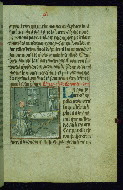
- Title: Cleric seated at table set with compass, dividers, and geometric shapes
- Form: Small miniature, 9 lines
- Text: Geometry
fol. 30v:
fol. 31v:
fol. 40v:
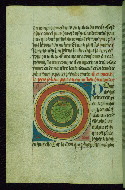
- Title: The earth and the spheres of the four elements
- Form: Diagram, 10 lines
- Text: Comment la terre se tient droit au fin milieu du monde
fol. 42r:

- Title: Roundness of the earth: men walking around circumference
- Form: Diagram, 17 lines
- Text: Comment la terre se tient droit au fin milieu du monde
fol. 42v:
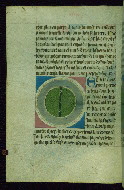
- Title: Roundness of the earth: distance traveled by stones cast to the center of the earth
- Form: Diagram, 9 lines
- Text: Comment la terre se tient droit su fin milieu du monde
fol. 43r:
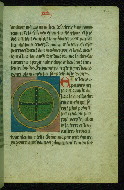
- Title: Roundness of the earth: distance traveled by stones cast to the center of the earth
- Form: Diagram, 10 lines
- Text: Comment la terre se tient droit au fin milieu du monde
fol. 43v:
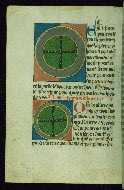
- Title: Roundness of the earth: distance traveled by stones cast to the center of the earth
- Form: Diagrams, 10 lines (top) and 7 lines (bottom)
- Text: Quelle la reondesse de la terre est
fol. 45r:
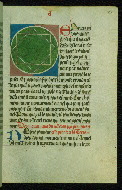
- Title: Roundess of the earth created by God
- Form: Diagram, 9 lines
- Text: Pour quoy dieu fist le monde reond
fol. 47v:
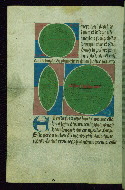
- Title: Three diagrams of the division of the earth
- Form: Diagrams, 6 lines (top) and 9 lines (bottom)
- Text: Chi commence la seconde partie de che present liure et declaire comment la terre est devisee et quelle part elle poeut estre habitee
- Comment:
Corners of top panel inscribed: "la pomme fendue en quatre quartie[r]s"; at the center of the folio, the diagram at the right reads: "la droite ligne de midi"
fol. 48v:
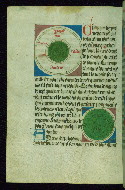
- Title: Division of the earth
- Form: Diagrams, 9 lines (top) and 6 lines (bottom)
- Text: Chi commence la seconde partie de che present liure et declaire comment la terre est devisee et quelle part elle poeut estre habitee
- Comment:
Top left diagram inscribed top center clockwise: "paradis / terrestre / terre / Midis / Occident / Mars / Septentrion"; the diagram below has the corners above inscribed: "Ori / ant," and the corners below: "Occi / dant"
fol. 49r:
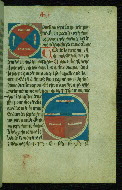
- Title: Diagrams of the division of the earth
- Form: Diagrams, 6 lines (top) and 8 lines (bottom)
- Text: Apres soit chascune partie tournee vers son nom en terre
- Comment:
The diagram at the top left has inscriptions from center top clockwise: "Orians / Mars / Occidant"; the diagram below has a blue top half of the earth labeled: "Ayse le grant" at the center and "Oriant" below at the left; the lower half of the earth is divided into red and pink quadrants, respectively labeled: "Septentr[i]on" and "Midi"
fol. 49v:
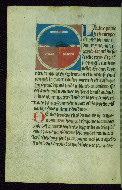
- Title: Diagram of the division of the earth
- Form: Diagram, 8 lines
- Text: Laultre partie si est Europe.
- Comment:
The top half of the diagram is inscribed: "Oriant / Ayse la grant / Midi"; pink and red quadrants below are respectively inscribed: "Europe / Anfrique"
fol. 90r:
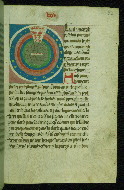
- Title: Spheres of the planets
- Form: Diagram, 10 lines
- Text: Car il auroit plustost fait son cours
- Comment:
From the innermost band out, the concentric circles are inscribed: "terre / yane / airs / feus / pur air / planetes"
fol. 91v:
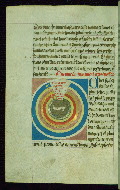
- Title: Spheres of the planets
- Form: Diagram, 11 lines
- Text: Du tour du firmament et des etoilles
- Comment:
Circles inscribed from the innermost out: "Terra / Mercurius / Venus / Sol / Mars / Jupiter / Saturnus"
fol. 93r:
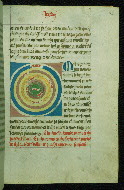
- Title: Spheres of the planets
- Form: Diagram, 10 lines
- Text: Du tour du firmament et des estoilles
- Comment:
Inscribed from the innermost circle out: "Terra / Mars / Luna / Mercurius / Jupiter / Venus / Sol / Saturnus"
fol. 94v:
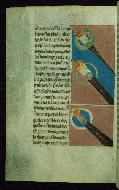
- Title: The sun, the moon, and the shadow of the earth
- Form: Diagrams, 14 lines (top) and 7 lines (bottom)
- Text: Chi declaire comment le iour et la nuit viennent
- Comment:
Basic components are a gold sun at top left labeled "Sol", a white area, a small earth labeled "Terra", and a black band of cast shadow. The three shadows are inscribed (from top down): "umbre engreant / umbre omn? / umbre angrossissant"
fol. 96v:

- Title: The sun, phases of the moon, and the shadow of the earth
- Form: Diagrams, 18 lines
- Text: Comment la lune rechoipt diversement sa clarte et lumiere poeut chascun veour y chi
- Label: Two diagrams each shows a pair of suns labeled "Sol," a small grey earth labeled "terra" and two black bands labeled "luna"
fol. 97v:

- Title: Lunar eclipse
- Form: Diagram, 9 lines
- Text: Comment les eclipses de la lune adviennent
- Label: Label "Sol" in the margin outside the diagram; "Luna" and "Ter/ra" are written to the left of the representation of the eclipse
fol. 98v:
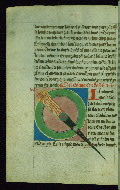
- Title: Solar eclipse
- Form: Diagram, 9 lines
- Text: Del eclipse du so.l.e.i.l.
- Label: Upper gray orb labeled "Terre," smaller silver moon below on black band labeled "Umbre engrellant"
fol. 100r:
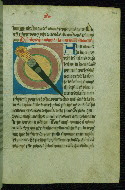
- Title: Solar eclipse at the time of the Crucifixion
- Form: Diagram, 9 lines
- Text: Del eclipse qui advint a la mort de nostre seigneur
fol. 131r:

- Title: Spheres of the firmament, Christ enthroned, and Evangelist symbols
- Form: Full-page miniature
- Text: Chi parle du celestiel paradis
- Label: Concentric spheres of the universe labeled from the center to the top: "Terre," "Yaue," "Air," "Feus," "Luna," "Mercurius," "Venus," "Sol," "Mars," "Jupiter," "Saturnus," "Firmamentum," "Celum nonu[m]," "Celum cristallinum," "Celum imperium"; names of the Evangelists are inscribed on the scrolls held by the symbols
The binding is not original.
Bound in Paris by León Gruel in the late nineteenth-early twentieth century with red morocco. Foliate motifs in blind on sides and spine. On the spine in blind: "Le miroire / Du Monde" "M.S. 1489" at tail-edge above binder's name "GRUEL"; crimson silk ribbon marker.
Made in Bruges, dated "14.89. 20. februarii" in colophon on fol. 134r
Unknown private collection, Paris, 1894
Léon Gruel and Edmond Engelmann collection, Paris, late nineteenth to early twentieth century; their bookplate on inside upper board, inscribed "No. 76"
Henry Walters, Baltimore, acquired from Gruel between 1900 and 1931
Walters Art Museum, 1931, by Henry Walters' bequest
Delisle, Léopold. Recherches sur la librairie de Charles V. Vol. 2. Paris: H. Champion, 1907; p. 302, cat. no. 141.
De Ricci, S. and W. J. Wilson. Census of Medieval and Renaissance Manuscripts in the United States and Canada. Vol. 1. New York: H. W. Wilson Company, 1935; p. 845, cat. no. 504.
Francis, Winthrop Nelson. The Books of Vices and Virtues. EETS. London: Early English Text Society, 1942; p. xx (ref. to 504, de Ricci number).
Miner, Dorothy. Illuminated Books of the Middle Ages and Renaissance: An Exhibition Held at the Baltimore Museum of Art. Exhibition Catalogue. Baltimore: Trustees of the Walters Art Gallery, 1949; cat. no. 134.
Meyers, Bernard Samuel. Encyclopedia of the Art World, vol. 10. New York: McGraw-Hill, 1959; p. cxi.
Destombes, Marcel. Mappemondes A.D. 1200-1500. Monumenta cartographica vetustoris aevi A.D. 1. Amsterdam: N. Israel, 1964; p. 143: 46.1.
McCulloch, F. "L'éale et la centicore: Deux bêtes fabuleuses." In Mélanges offerts à René Crozet. Edited by P. Gallais and Y.-J Riou. Vol. 2. Poitiers: Société d'études médiévales, 1965; p. 1168 (n. 4).
Diringer, David. The Illuminated Book: Its History and Production. London: Faber and Faber, 1967; p. 454 (pl. vii-35b).
Bowles, Edmund A. "A Checklist of Musical Instruments in Fifteenth-Century Illuminated Manuscripts at the Walters Art Gallery." Quarterly Journal of the Muisc Library Association 32, no. 4 (1976): 719-726; pp. 720-722, 724.
Evans, Michael. "Allegorical Women and Practical Men: The Iconography of the Artes Reconsidered." In Medieval Women. Edited by Derek Baker. Oxford: Basil Blackwell, 1978; pp. 315, 318 (n. 76).
Howard, Donald R. Writers and Pilgrims: Medieval Pilgrimage Narratives and Their Posterity. Berkeley: University of California Press, 1980; frontispiece illustration (f. 42).
National Endowment for the Humanities. Annual Report. Washington D.C., 1984; p. 6 (illus. of f. 94v).
Randall, Lilian M. C. Medieval and Renaissance Manuscripts in the Walters Art Gallery. Vol. 3, pt. 2. Baltimore: Johns Hopkins University Press, 1997; pp. 438-447, cat. no. 283.
Nevins, Teresa. "Image du Monde." In Medieval Mastery: Book Illumination from Charlemagne to Charles the Bold (800-1475). Edited by William Noel and Lee Preedy. Turnhout: Brepols, 2002; pp. 324-325, cat. no. 91.
Newman, Paul B. Growing Up in the Middle Ages. Jefferson, NC: McFarland and Company, 2007; pp. 116 (fig. 27), 131 (as fig. 27).
Roux, Brigitte. Mondes en miniatures: L'iconographie du Livre du trésor de Brunetto Latini. Paris: Libraire Droz, 2009; p. 266.
Principal cataloger: Randall, Lilian M.C.
Cataloger: Valle, Chiara
Editor: Herbert, Lynley
Copy editor: Dibble, Charles
Conservator: Owen, Linda
Contributors: Emery, Doug; Herbold, Rebekah; Noel, William; Schuele, Allyson; Tabritha, Ariel; Toth, Michael B.; Valle, Chiara; Wiegand, Kimber
The Walters Art Museum
Licensed for use under Creative Commons Attribution-ShareAlike 3.0 Unported Access Rights, http://creativecommons.org/licenses/by-sa/3.0/legalcode. It is requested that copies of any published articles based on the information in this data set be sent to the curator of manuscripts, The Walters Art Museum, 600 North Charles Street, Baltimore MD 21201.
